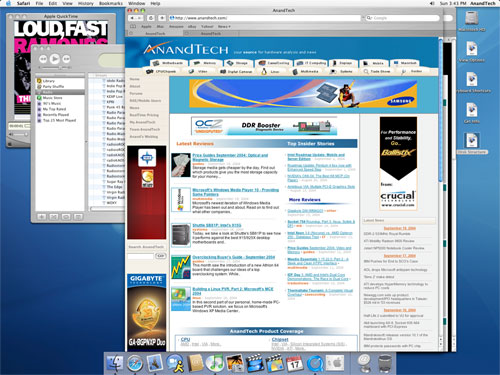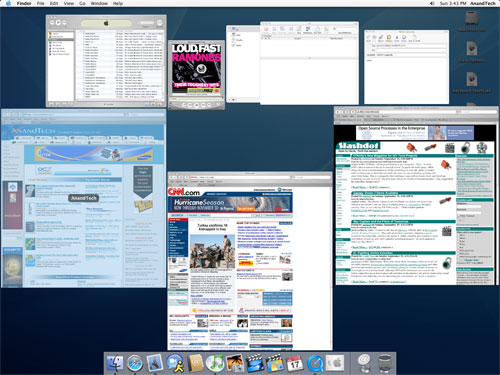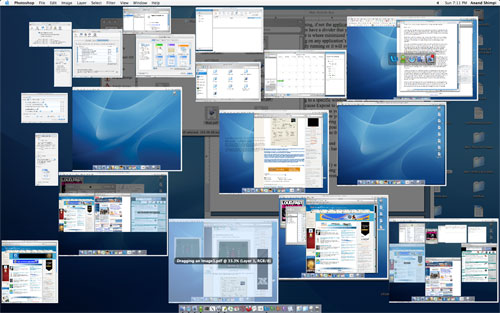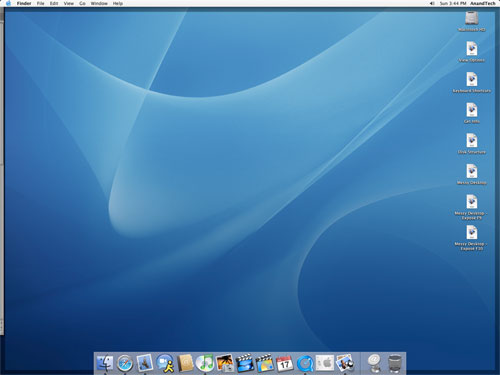A Month with a Mac: A Die-Hard PC User's Perspective
by Anand Lal Shimpi on October 8, 2004 12:05 AM EST- Posted in
- Mac
Perfect Multi-tasking
So far, I've described OS X's multi-tasking as very similar to what is currently available under Windows, but where OS X sets itself apart is in a little feature called Exposé (note that typing an accented "e" is extremely easy under OS X - ALT-e followed by the "e" key or any vowel will do just that).By default, Exposé is activated by one of three function keys - F9, F10 or F11. Each function key serves a different purpose, each of which is a feature of Exposé. The theory behind Exposé is simple: it is a way of getting to a specific window on your desktop as fast as possible.

We start with our cluttered desktop...
Click to enlarge.
Hitting F9, for example, will cause Exposé to zoom out all of your active visible (unhidden) windows and essentially, tile them across your desktop. Then, using either the keyboard or the mouse, you can select the window that you want and everything goes back to normal, with the window that you have selected appearing in the foreground. The rest of the windows are untouched and are all in their original positions. The window that you selected is also in its original position; it is simply moved to the front so that you can see it.

Hitting F9 activates Exposé across all applications.
Click to enlarge.
If you don't want to Exposé all windows, you can just Exposé the windows within a particular application (F10 by default), which is extremely handy for dealing with tons of images in Photoshop for example.

Hitting F10 activates Exposé across only a single application's windows.
Click to enlarge.

Another example of Exposé's usefulness in editing all of the images for this article in Photoshop.
Click to enlarge.
The final Exposé function lets you view your desktop (F11), which, to me, was like a more polished version of Windows-D, since after I was done doing whatever it is I needed to do on the desktop, Exposé deactivated and my screen was restored to its original state.

Hitting F11 reveals the desktop.
Click to enlarge.
The beauty of Exposé is difficult to convey in text alone. Honestly, the best way to evaluate it and understand its potential is to use it - luckily, there are Apple stores for this very purpose. Keep in mind that Exposé is very customizable as well and the three function keys that I mentioned above, although the defaults, are not the only ways that you can configure OS X to activate Exposé.
The benefits of Exposé are numerous. If you ever feel overwhelmed by having too many windows open, Exposé definitely alleviates that feeling as you don't have to tab through multiple applications to finally get to the window that you want. While Exposé does make having only a single display better, heavy multi-taskers will still enjoy the benefits of a dual display setup.
Since the OS X desktop environment is completely OpenGL accelerated, the performance of features like Exposé are not CPU limited - instead, they are GPU limited. Luckily, using Exposé with many windows open is not very stressful on even a Radeon 9600, but you do run out of video memory very quickly - in which case, your system ends up swapping to main memory over the AGP bus, making the Exposé animation considerably choppy. It seems that the sweet spot for more than a handful of windows open is around 128MB of video memory, with 256MB being perfect - needless to say, I found the mere 64MB that came on the Radeon 9600 which shipped with the system to be too little. There is no detriment to functionality if you don't have enough video memory; the Exposé animation simply becomes more choppy (which can be annoying on a $3000 system).










215 Comments
View All Comments
victorpanlilio - Saturday, October 9, 2004 - link
Correction: In my post (#104) I listed "Bruce Forno" -- it should read "Richard Forno" in case people wish to verify in Googlevictorpanlilio - Saturday, October 9, 2004 - link
WaltC wrote: "as far as "going and learning" about the Mac is concerned, I know all I care to know" -- which can be another way of saying, "I prefer to wallow in my current abysmal state of ignorance". OK Walt, I'll tweak your nose a bit -- the people listed below prefer MacOS X over WinXP:Tim Berners-Lee -- invented the web
James Gosling -- invented Java (used to build his own PCs)
Tim Bray -- co-invented XML
Bruce Forno -- past CISO*, Network Solutions
Bruce Schneier -- CTO**, Counterpane
Richard Clarke -- past CISO, US Govt
Bill Joy -- co-founder and past CTO, Sun Microsystems
Tim O'Reilly -- CEO, O'Reilly and Associates
You can easily confirm the above through Google.
*CISO = Chief Information Security Officer
**CTO = Chief Technology Officer
Bill Gates' own home PCs were recently hit with malware:
http://news.zdnet.com/2100-1009_22-5393208.html
Hmmm...
If the Chief Software Architect of Microsoft can't even maintain the security on his own personal machines, what can we expect of people who are running IE on pre-SP2 WinXP?
At home, I have a Dell PowerEdge server I use for testing Win2K3 Enterprise, but I run OS X 10.3.5 on an 800MHz iBook G4 and a 4-yr old G4/400; the small company I currently work for runs Win2K3 and OpenBSD, and we're testing MacOS X Server 10.3.
Try to be more open-minded and curious about things you don't know much about. Young children evince this quality in spades, until arrogant adults ruin it for them. Whatever shortcomings or gaps Anand's article may have, so long as he wishes to continue educating himself, he is to be commended. If the subsequent discussions in this forum could proceed in a spirit of learning rather than descend into declarations of omniscience, we might all benefit from the interchange. Tim Berners-Lee envisions the web as a place where learning can take place for everyone. It'd be great, I think, if we took him up on it.
ocelotwreak - Saturday, October 9, 2004 - link
Dear Anand Lal Shimpi,Just wanted to send some kudos to you for a very well written and objective review of the state-of-the-Mac. I am a long time Mac user (as well as Windows, Linux, Solaris, Irix, MVS, and others for over 35 years), and have to admit I love the Mac. I use a 17" PowerBook for everything from writing huge Office documents to editing video using Final Cut Pro.
You did an excellent job of pointing out the good with the warts. I concur with your dislikes, although I use MS Office on the Mac almost exclusively because I can get more done faster on the Mac than I can using Office on XP. I write 1000 page reports for a living, and I would shoot myself trying to get it done using Office on XP, which in comparison I find to be a totally psychotic experience!
I concur that Mail is the weakest OS-X application, and also suffer the most crashes there, usually importing big Word attachments to emails. You missed the "fast user switching" option on Exposé, which is a real jaw-dropper the first time you show it to Windows (and Mac) folk. Also, try click-drag an image off your web page, Function F9 to tile all the windows, hover the dragged image over the window you want to go to, watch it automatically zoom to foreground, and then drop it into the now active app where you want it to end up, is another stunning productivity accelerator. (That requires more complexity to describe it than to just intuitively do it!)
Keep up the good work! Regards,
-Walter Cooke
brichpmr - Saturday, October 9, 2004 - link
I admin XP all day long, #99, and I can tell you that context menu functions on OSX are easily the equal of XP. Aside from that, I generally replace whatever mouse comes with the PC too..By the way, a very nice shareware app on OSX, Fruit Menu, offers a large number of additional configurable context options for the right mouse button...check this kind of stuff out...it's very cool.
WaltC - Saturday, October 9, 2004 - link
#100....Heh...;) Thank you for commenting on my ignorance, but it appears to me you completely missed the point I was making about the one button mouse.First, the point was the same one Anand made, that what ships from Apple is not "the Microsoft 5-button Intellimouse optical" mouse, but a one-button mouse, instead.
Second, thanks for educating me in that just like in WinXP, the "right mouse button" under OS X brings up a context menu of choices. So, apparently what you are saying is that OS X is exactly the same as WinXP in that regard, which I certainly did not know...;) Thank you for this information. My point was only that Anand did not specify in his article what it was that pressing the right mouse button under OS X did. Thank you for filling in that info...;) Was I also wrong in thinking that OS X provides a keypress & mouse button combo to bring up the OS X context menu you have assured me exists?
Heh....;) Seriously, as far as "going and learning" about the Mac is concerned, I know all I care to know. But thanks anyway for the suggestion!
brichpmr - Saturday, October 9, 2004 - link
#99, your post confirms that you need to go get educated about Macs...the sheer ignorance is staggering. Just one example....the Microsoft 5-button Intellimouse optical I use on Mac and PC platforms has the same functionality on both. Go learn, then come back...WaltC - Saturday, October 9, 2004 - link
(Clipped from my comments in another forum)If you ask me, the article boils down to Anand desperately trying to rationalize his $3k 2GHz G5 purchase so that he can avoid hitting himself over the head with a baseball bat while cursing his own stupidity and asking himself "What was I thinking?"...;)
Salient points to me were these:
*While he mentions replacing the one-button mouse that Apple has locked itself into on the grounds that Steve Jobs is convinced Mac users are too challenged mentally to cope with the prospect of plural mouse buttons, he never actually makes any mention of what benefit, if any, he got from using a mouse with more than one button under OS X--not surprising, since OS X is written to support the standard shipping Mac hardware configuration. But as Anand most clearly specified a preference for keyboard controls anyway, it's a bit of a wonder to me why he bothered to replace the mouse at all. I think I read something awhile back about being able to use a key press plus the mono mouse button to duplicate the function of the second mouse button under OS X, but Anand doesn't bother to tell us what that function might be under OS X, unfortunately, if he knows, of course.
*Talks about "replacing things" like the shipping ram and the 3d-card in his $3k G5 Mac, but doesn't bother to add the increased costs into the $3k price he repeats constantly throughout, nor does he tell us how much his two Cinema monitors added to the price (unless I missed that.)
Adding in these costs would--what?--double the $3k price he mentions? What really mystifies me about the way the article is written is what might've prompted Anand to think that a 64mb, 4-pixel-per-clock 3d-card and 256mbs of ram per cpu would have been sufficient in the first place. I mean, if he had stated that he was unable to purchase the Mac from Apple direct with any greater hardware specs than what he got, then fine. But he doesn't say anything like that as I recall. Obviously he would not be content with those specs in his x86 box, so why would he be surprised they weren't enough for his G5 box?
That is one of my pet peeves with this "impression" article as Anand has written it--he constantly states "$3k" throughout when the true cost of the system he's running is far, far higher. Like I say, though, it's probably just a part of his subconscious rationalization as to not wanting to face what his Mac G5 system *really* cost him...;)
*He talks consistently about the "8GB" limit to memory in the G5 box, but *unless I am mistaken* that's a bit misleading as the limit is actually 4GBs--for each cpu--so with 8 gigs installed the actual limit is still 4GBs.
*Would have been nice to see him examine his other shipping hardware config, apart from this barebones description:
Dual 2GHz 0.13-micron G5 CPUs
512MB CAS3 DDR400 SDRAM
160GB SATA HDD
ATI Radeon 9600 (64MB)
...as to things like HD brand & performance, the brand of SATA controller on the motherboard, etc. He doesn't seem to want to get anymore specific about component identification and subsystem performance than Apple itself wants to get, and I have to say that bothers me.
*The last point he makes is pretty much a clincher for me, though, in that he's honest about the G5 box simply not being able to take the place of his x86 box on several levels. So now, in addition to adding more ram per cpu and a decent middle of the road 3d card, along with his preference for twin Cinema displays, we also have to add the cost of a decent x86 box into the mix--and so we're actually talking maybe 2.5x the original $3k price Anand keeps repeating through the article (even though his system is now around $2400, the $3k range being reserved for Apple's so far no-show 2.5GHz G5 boxes--at least "no-show" from what I've read recently.)
*A very minor point, certainly, but Anand should know that M$ is constantly criticized for building in too much functionality into its OS's, on the grounds that M$ is doing so to run other software companies out of business (a criticism I do not personally agree with.) Yet, when Apple does things like build in a whole lot of functionality into its OS, including its own browser, why it's just a "cool, wonderful thing"...;) In fairness to Apple, though, Apple has to do it since the platform cannot support enough independent developers to do it, unlike is the case for M$. Still, the double standard there is always amusing to read...;)
*Last minor nitpick. I can tell Anand has been deeply engrossed within the online Mac community's propaganda mill, simply because he keeps talking about "DOS" and difficulties with x86 peripherals and drivers circa 1995 and earlier. I've had some experience myself with the Mac online community and know that many of them are locked into a perpetual loop which pretends that all that is x86-Windows is no different now than it was in 1995. These people frequently get stuck in delusionary time warps in which the only thing that has changed in the last decade is Apple, and its a bit sad to see that some of that prejudice is rubbing off on Anand--who, frankly, should know better than to allow it to influence him in the slightest--primarily because such assumptions about x86 hardware and software simply are not true.
In summary, I agree with Anand's opening statements as to how "hard" it was for him to write this article, as for someone in his position as a medium-profile, computer-hardware Internet pundit, it must be really embarrassing to admit he got snookered by Apple's marketing claims to the extent that he actually shelled out $3k+ of his personal pocket money just to discover what he should already have known, that buying a Mac wasn't at all going to allow him to retire his x86-Windows box, for a number of compelling reasons. An expensive lesson to learn, certainly. I hope he'll do another article later called "After 6 months with a Mac," as I wouldn't be surprised to learn he'd sold it or donated it to charity by then...;)
gankaku - Saturday, October 9, 2004 - link
#96 "I think that applies to servers too you know. If dmr9748 can spend peanuts to run a Linux server on 400MHz processors with 512MB memory to do what he needs done why does he even need to consider a Xeon or G5 Xserve?"Of course that's true. But the argument cuts both ways. Some time ago, I ran a web and mail server off a used iMac (400 MHz, with 320 MB RAM) that easily saturated a partial T1. The iMac cost about $600 Canadian. I took the server down awhile ago, but the iMac still chugs along happily, folding proteins for the betterment of humanity. :-)
saszmidt - Saturday, October 9, 2004 - link
Good article! Thanks!One point though. You have interesting ideas of what constitutes reliable uptime. Several months is not a good value, though better than weeks. The only reason any unice box should go down is due to hardware failure. I don't care how many years later, it should still run.
Anything else is a poorly built machine.
Getting better uptime with XP than Linux just shows you either had poor hardware or did not know how to build a proper Linux server.
Linux servers I build never crash. True, you can have some app that eats up all memory and eventually it will die. But that's not O/S related, that's just poorly written s/w. Linux deals with crashing apps much better than windows does any time of the day.
Only getting a Linux box to run for months is indicative of not knowing your stuff. I.e. you did not put the same amount of effort into learning about it as you did with a windows box.
You have s/w under Linux which will check for memory leaks, so that's not a valid excuse.
http://www.thefreecountry.com/sourcecode/debugging...
Too many goofy windows admins try to build Linux boxes and then say goofy things like "pretty reliable - it ran for several months". Only because thats a WINDOWS standard.
kitsura - Saturday, October 9, 2004 - link
I think you're missing the point its not a direct price to performance comparison."I would rather blows 1 dollar on ebay to get a Tandy 1000 with word perfect 1.5 before I spend 2400 dollars on a machine that does exactly the same thing with the processing power to do more but is limitted by its impact on the computer market."
I think that applies to servers too you know. If dmr9748 can spend peanuts to run a Linux server on 400MHz processors with 512MB memory to do what he needs done why does he even need to consider a Xeon or G5 Xserve?